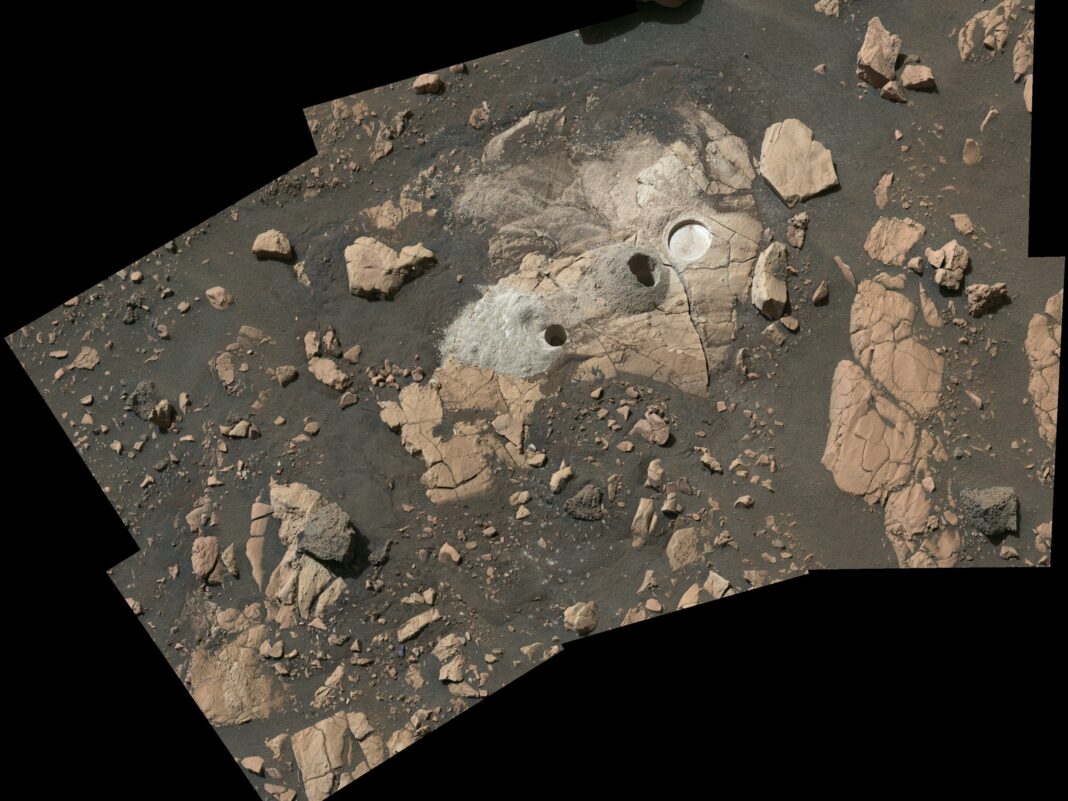After trundling around the Jezero crater for 550 Martian days, NASA’s Perseverance rover has amassed nearly half its planned rock collection—including some containing organic molecules, a possible sign that life could have thrived there more than 3 billion years ago. These are compounds that contain carbon, and often hydrogen or oxygen, which are likely crucial to life forming. “We have discovered rocks that were deposited in a potentially habitable environment in that lake, and we have been seeking potential biosignatures,” which may have been produced by life, said Ken Farley, the Perseverance project scientist at Caltech, speaking today at a press conference at NASA’s Jet Propulsion Laboratory in Pasadena, California.
In fact, the Perseverance team picked the crater as the rover’s landing spot for that reason. It appears to be the site of an ancient river delta—a convenient location for microorganisms to have emerged and evolved long ago, and a shot at finally answering the question “ Are we alone in the cosmos ?” Still, Farley emphasizes, organic molecules might have been produced by other means—it’s possible to make them through abiotic natural processes too. But Percy, as the rover is sometimes called, can’t conclusively determine their origin on its own.
That’s why NASA and the European Space Agency are planning a sample return mission to pick up a variety of rocks from the region and ship them back to Earth in the early 2030s. The Perseverance team expects the rover to have a long lifespan, like its predecessor, Curiosity , which is still running. (Perseverance is actually NASA’s fifth rover to be deployed to the Red Planet.
) Their preferred plan is to have Perseverance deliver the team’s favorite rock samples to a new lander equipped with a small rocket, which will launch the samples to an orbiter, which will then fly them to Earth. If the mission goes as planned, the team will launch the orbiter and lander from Earth to Mars in 2027 and 2028, respectively. The spacecraft loaded with rock samples will transport them to the western Utah desert in 2033.
NASA has a backup plan, too. In case something happens to Percy over the next few years, the rover will also cache some samples in a safe, flat place where they can be retrieved easily. Because there’s hardly any weather on the planet, and few major marsquakes that could harm the samples, the cache should remain untouched until the lander comes.
That mission will also include two helicopters—built like the Ingenuity craft that’s already aiding Perseverance’s mission—which could be used to retrieve samples. Mars is completely unlivable today. Because the planet has very little of its atmosphere left, it’s a cold and arid wasteland, highly exposed to space radiation.
But scientists believe that billions of years ago, it could’ve been a far more hospitable place, when it was more temperate and home to flowing liquid water. That makes it the closest world to Earth that could have once been inhabited— even if only by microbes . Perseverance’s travels have revealed that Jezero is a geologically rich crater, with igneous and sedimentary rocks scattered about it.
Not only did the crater likely hold a lake and river delta long ago, but before that, it was the site of volcanic activity. Scientists use Percy to collect samples by wheeling to a compelling spot—identified by its SHERLOC and WATSON cameras— drilling into a rock and storing samples in a heavy-duty test-tube-like container in its belly. Scientists have used the rover to successfully fill 12 tubes so far, plus some control samples.
It holds a total of 43 tubes. While Farley and his colleagues are excited about Perseverance’s discovery of organic molecules on Mars, it’s not the first rover to do so. Nine years ago, Curiosity came across organic matter in some rock powder samples.
But Percy’s current location, in a rocky outcrop called Wildcat Ridge, seems more promising in terms of those materials being signs of life. It has a larger concentration of organics, including sulfate minerals, and the location seems more likely to be one that could have supported biology. The Perseverance team has also acquired evidence about the crater’s past from a sample at another outcrop, dubbed Skinner Ridge, revealing that some rocks indeed came from far away, likely transported by the ancient river before settling in the lake bed.
“I think it’s safe to say these are two of the most important samples we’ll collect on this mission, and we’re all very excited about what we’ve found,” said David Shuster, the Perseverance return-sample scientist at UC Berkeley, at today’s press conference. “Both of these have high scientific value for the next generation of scientists when they’re returned to Earth. ”.
From: wired
URL: https://www.wired.com/story/nasas-perseverance-rover-digs-up-organic-molecules-on-mars/



